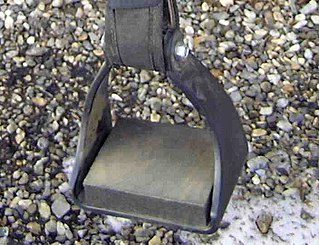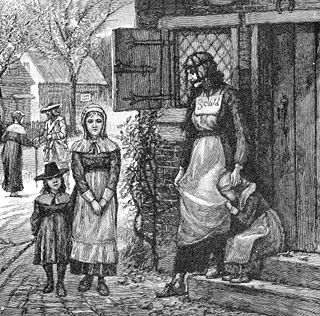Tack is equipment or accessories equipped on horses and other equines in the course of their use as domesticated animals. This equipment includes such items as saddles, stirrups, bridles, halters, reins, bits, and harnesses. Equipping a horse is often referred to as tacking up, and involves putting the tack equipment on the horse. A room to store such equipment, usually near or in a stable, is a tack room.

A handicraft, sometimes more precisely expressed as artisanal handicraft or handmade, is any of a wide variety of types of work where useful and decorative objects are made completely by one's hand or by using only simple, non-automated related tools like scissors, carving implements, or hooks. It is a traditional main sector of craft making and applies to a wide range of creative and design activities that are related to making things with one's hands and skill, including work with textiles, moldable and rigid materials, paper, plant fibers, clay, etc. One of the oldest handicraft is Dhokra; this is a sort of metal casting that has been used in India for over 4,000 years and is still used. In Iranian Baluchistan, women still make red ware hand-made pottery with dotted ornaments, much similar to the 5,000-year-old pottery tradition of Kalpurgan, an archaeological site near the village. Usually, the term is applied to traditional techniques of creating items that are both practical and aesthetic. Handicraft industries are those that produce things with hands to meet the needs of the people in their locality without using machines.

A cowboy is an animal herder who tends cattle on ranches in North America, traditionally on horseback, and often performs a multitude of other ranch-related tasks. The historic American cowboy of the late 19th century arose from the vaquero traditions of northern Mexico and became a figure of special significance and legend. A subtype, called a wrangler, specifically tends the horses used to work cattle. In addition to ranch work, some cowboys work for or participate in rodeos. Cowgirls, first defined as such in the late 19th century, had a less-well documented historical role, but in the modern world work at identical tasks and have obtained considerable respect for their achievements. Cattle handlers in many other parts of the world, particularly South America and stockmen and jackaroos in Australia, perform work similar to the cowboy.

The Black Country is an area of England's Midlands. It is mainly urban, covering most of the Dudley, Sandwell and Walsall Metropolitan Boroughs, with the City of Wolverhampton sometimes included. The towns of Dudley and Tipton are generally considered to be the centre.

A stirrup is a light frame or ring that holds the foot of a rider, attached to the saddle by a strap, often called a stirrup leather. Stirrups are usually paired and are used to aid in mounting and as a support while using a riding animal. They greatly increase the rider's ability to stay in the saddle and control the mount, increasing the animal's usefulness to humans in areas such as communication, transportation, and warfare.

Walsall is a market town and administrative centre in the West Midlands County, England. Historically part of Staffordshire, it is located 9 miles (14 km) north-west of Birmingham, 7 miles (11 km) east of Wolverhampton and 9 miles (14 km) from Lichfield.

A scold's bridle, sometimes called a witch's bridle, a gossip's bridle, a brank's bridle, or simply branks, was an instrument of punishment, as a form of public humiliation. It was an iron muzzle in an iron framework that enclosed the head. A bridle-bit, about 5 cm × 2.5 cm in size, was slid into the mouth and pressed down on top of the tongue, often with a spike on the tongue, as a compress. It functioned to silence the wearer from speaking entirely, and caused extreme pain and physiological trauma to scare and intimidate the wearer into submission. The scold's bridle was used primarily on women. This prevented speaking and resulted in many unpleasant side effects for the wearer, including excessive salivation and fatigue in the mouth. For extra humiliation, a bell could also be attached to draw in crowds. The wearer was then led around town by a leash.

A handbag, commonly known as a purse in North American English, is a handled medium-to-large bag used to carry personal items. It has also been called a pocketbook in parts of the U.S.

John Henry Carless was a British recipient of the Victoria Cross during the First World War.

The Saddlers Centre is a shopping centre located in Walsall, West Midlands, United Kingdom. The shopping centre takes its name from the town's saddle manufacturing heritage and is also known as the nickname for the towns football team Walsall FC.

Lahıc is a village and municipality on the southern slopes of Greater Caucasus within the Ismailli Rayon of Azerbaijan. Population is approximately 860 people who speak the Tat language, also known as Tati Persian, a Southwestern Iranian language spoken by the Tats of Azerbaijan and Russia.

The Walsall Canal is a narrow canal, seven miles (11 km) long, forming part of the Birmingham Canal Navigations, and passing around the western side of Walsall, West Midlands, England.

The Igualada Leather Museum, located in Igualada, Catalonia, was created in 1954 and was the first leather museum in Spain, and the third one in Europe. The collections are displayed in two nearby buildings in Igualada: the "Cal Boyer" building, a former cotton textile factory from the late 19th century, and the "Cal Granotes" building, an 18th-century tannery.
Charlbury Museum is a local museum in the town of Charlbury, Oxfordshire, England. The museum and collections are organized and run by the Charlbury Society, which was founded in 1949.
Barnsby Saddles was a saddlery based in Walsall, England. At its peak, it was among the top five saddlery businesses in the world, exporting saddles and other leather goods all over the world. The company made ceremonial equipment for many military units round the world, including the Royal Horse Artillery, the Household Cavalry and various Police Forces.

G Ettinger Limited is a British company, based in London, specialising in luxury leather goods. Founded in 1934 by Gerry Ettinger, the eponymous company is still 100% family-owned and run.

Kura (鞍), is the generic name for the Japanese saddle. The word "kura" is most commonly associated with the saddle used by the samurai class of feudal Japan. Over time the Japanese added elements of their own until the Japanese saddle became an identifiable style, also known as the samurai saddle.

Jalisco handcrafts and folk art are noted among Mexican handcraft traditions. The state is one of the main producers of handcrafts, which are noted for quality. The main handcraft tradition is ceramics, which has produced a number of known ceramicists, including Jorge Wilmot, who introduced high fire work into the state. In addition to ceramics, the state also makes blown glass, textiles, wood furniture including the equipal chair, baskets, metal items, piteado and Huichol art.
Launer London is a British manufacturer of luxury handbags and other small leather goods founded in 1940 by Sam Launer, who emigrated to London from Czechoslovakia during the Second World War. The company first sold a handbag to a member of the British royal family in 1950 and subsequently was awarded a royal warrant by Queen Elizabeth II.
















